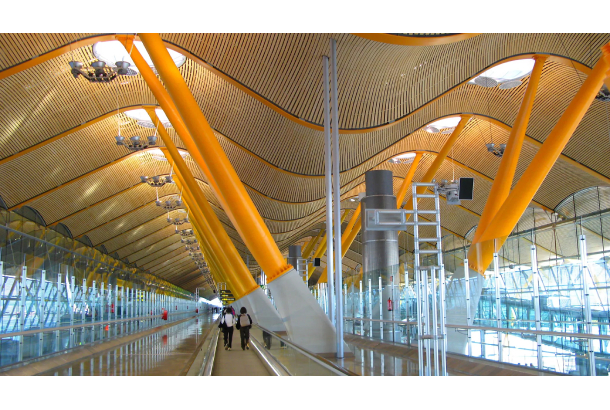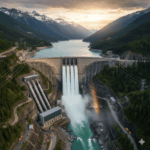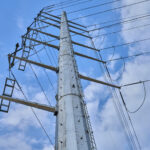Roofing: Enhancing safety, sustainability and aesthetics
In recent years, roofing solutions, once seen as mere structural coverings, have evolved significantly. Modern roofing now integrates safety, sustainability, and aesthetics, offering enhanced durability and energy efficiency. With advancements in technology, roofing solutions are becoming more customized, incorporating smart features like heat-reflective coatings and solar integration to improve indoor comfort. This article explores the latest trends in roofing solution…
A building's roof is more than just a protective covering – it plays a crucial role in ensuring structural integrity, energy efficiency, and aesthetic appeal. As construction practices evolve and sustainability takes center stage, the roofing industry is witnessing a shift toward advanced materials, innovative designs, and eco-friendly solutions. From traditional clay tiles to modern solar-integrated roofs, the sector is adapting to meet the demands of durability, cost-effectiveness, and environmental responsibility. Roofing options today are diverse, catering to different climates, architectural styles, and budget considerations. Some of the most common types include asphalt shingles, which are cost-effective and widely used in residential construction; metal roofing, known for its durability and energy efficiency; and concrete or clay tiles, which provide a classic aesthetic with excellent longevity. For eco-conscious buildings, green roofs with vegetation layers and solar roofs integrating photovoltaic panels are gaining traction. Additionally, flat and membrane roofs are commonly used in commercial structures for their low maintenance and energy efficiency benefit. According to latest industry report, polycarbonate roofing sheets are gaining popularity due to their ease of installation and suitability for industrial and large-scale commercial buildings. Known for their durability and weather resistance, these sheets require minimal maintenance and are available in a variety of textures and designs. Beyond conventional applications, polycarbonate sheets are widely used in skylights, swimming pools, walkways, and display signboards, thanks to their lightweight nature and ability to allow natural light while blocking harmful UV rays. Their versatility and long lifespan make them a preferred choice across multiple sectors, driving their increasing demand in the roofing market. The roofing market caters to a broad spectrum of applications, ranging from residential housing and commercial complexes to industrial warehouses and large-scale infrastructure projects. Each segment has unique requirements, influenced by factors such as climate conditions, durability, energy efficiency, aesthetics, and structural integrity. While residential buildings often prioritise cost-effective and visually appealing options, commercial and industrial sectors demand high-performance roofing solutions that offer longevity, insulation, and weather resistance.
Expanding market
The Indian roofing industry is experiencing remarkable growth, driven by rapid urbanization, industrial expansion, and a surge in large-scale infrastructure projects. With government initiatives such as Smart Cities, airport modernization, affordable housing, and highway construction gaining momentum, the demand for durable, cost-effective, and energy-efficient roofing solutions is on the rise. “India's industrial and infrastructure growth in recent years has been nothing short of impressive, and it is certainly creating new opportunities for the roof and wall cladding solutions market. With Government focusing on ambitious infrastructure projects like the National Infrastructure Pipeline and the Smart Cities Mission, the demand for reliable, durable, and energy-efficient roofing materials is increasing significantly,” says Anoop Kumar Trivedi, Managing Director, Tata BlueScope Steel. Additionally, the shift towards sustainable construction practices has increased interest in eco-friendly roofing materials like solar-integrated roofs, green roofs, and cool roofing systems that help reduce energy consumption. According to Mordor Intelligence, the India Roofing Market size is estimated at USD 8.08 billion in 2025, and is expected to reach USD 11.07 billion by 2030, at a CAGR of 6.5 percent during the forecast period (2025-2030).
Emerging technology trends
The roofing industry is evolving rapidly, integrating new technologies and innovations that enhance performance, durability, and sustainability. With a growing emphasis on energy efficiency and environmental responsibility, green and sustainable roofing solutions are gaining much-needed attention. Cool roofing systems, designed with reflective coatings and adequate insulation, help mitigate urban heat effects while reducing energy consumption. Similarly, solar rooftops and Building-Integrated Roofing (BIR) solutions are emerging as key trends, allowing roofs to seamlessly incorporate solar panels, green roofing, and rainwater harvesting systems without compromising aesthetics. Smart roofing systems equipped with IoT sensors are becoming more common, enabling real-time monitoring of temperature, moisture levels, and structural integrity. These technologies allow predictive maintenance, reducing repair costs and enhancing longevity. Additionally, drones and 3D scanning technologies are transforming the way roofing projects are planned, managed, and executed, improving accuracy and efficiency in installations and inspections. Modular roofing systems are also gaining traction due to their high level of customisation, allowing structures to meet specific building codes and aesthetic preferences while offering a flexible and scalable solution for residential, commercial, and industrial buildings.
The rise of artificial intelligence (AI) and machine learning is further revolutionizing roofing design, installation, and maintenance. AI-driven analytics help in selecting optimal materials, predicting weather-related wear and tear, and automating project planning. Meanwhile, automated systems and robotics are being developed to assist with roof installation, maintenance, and repair, reducing labor-intensive tasks and improving precision. The industry is also seeing advancements in self-healing roofing materials, which use nanotechnology to repair minor cracks and leaks, extending the roof’s lifespan. As sustainability and efficiency continue to drive innovation, the roofing industry is poised for transformative advancements. From fire-resistant and impact-resistant roofing to prefabricated and modular roofing solutions, modern technologies are making roofing more durable, cost-effective, and environmentally friendly. With ongoing developments, the future of roofing will be defined by smarter, greener, and more integrated systems that enhance both functionality and aesthetics.
Challenges galore amidst steady growth
Though the roofing industry has grown rapidly in recent years, there are galore of challenges that are hindering further growth of the industry. One major challenge is the high initial cost of advanced roofing solutions, such as solar-integrated roofs, insulated panels, and green roofing, which limits their adoption, particularly in cost-sensitive segments. Furthermore, the fragmented nature of the industry, with a mix of organised and unorganised players, leads to inconsistencies in product quality, pricing, and distribution. The fluctuating prices of raw materials, particularly steel, aluminum, and polycarbonate, have made cost estimation a significant challenge for both manufacturers and consumers. The lack of awareness about modern roofing solutions remains a challenge, particularly in rural and semi-urban areas, where traditional materials are still widely preferred despite the benefits of energy-efficient and durable options. “Educating consumers about the benefits of high-quality, long-lasting steel roofing solutions, compared to lower-grade alternatives, is one of the key aspects of all our brand campaigns. Emphasizing on quality, durability and sustainability attributes of our solutions, plays a major differentiator as compared to the unorganized sector,” says Anoop Kumar Trivedi.
The sector also faces a skilled labour shortage, making the installation of advanced roofing systems, such as standing seam metal roofs and modular roofing panels, more difficult. Furthermore, India’s diverse and extreme weather conditions, including heavy monsoons, high temperatures, and cyclones, require roofing materials that can withstand environmental stress, adding to the complexity of material selection. Sustainability and recycling issues persist due to the lack of a structured framework for repurposing roofing waste. Additionally, regulatory hurdles and weak enforcement of building codes result in subpar installations and non-compliance with safety standards. The slow adoption of smart roofing technologies, such as IoT-enabled monitoring and AI-driven predictive maintenance, is another setback, as these solutions require significant investment and technical expertise.
Moreover, logistics and supply chain disruptions affect the timely availability of roofing materials, particularly in remote locations, leading to project delays and increased costs. Despite these challenges, the Indian roofing industry is steadily evolving with technological advancements, improved regulatory frameworks, and growing awareness of energy-efficient and sustainable solutions, paving the way for long-term growth and innovation.
Metal roofing in demand
Of late, there has been a significant increase in the use of metal roofing, driven by the growing demand for Pre-Engineered Buildings (PEBs) across industrial, commercial, and infrastructure projects. According to Research and Market report, the India metal roofing market is projected to grow at a CAGR of 7.8% between 2024 and 2032to reach a value of about USD 2.439 billion by 2032. As PEBs offer faster construction, cost efficiency, and structural flexibility, the need for durable, lightweight, and low-maintenance roofing solutions has surged. Metal roofing sheets, particularly galvanized and galvalume-coated steel, have emerged as the preferred choice due to their high strength, corrosion resistance, and long lifespan, making them ideal for warehouses, factories, and large commercial spaces. Additionally, advanced roofing solutions such as standing seam metal roofs are gaining popularity due to their superior water-tightness, energy efficiency, and aesthetic appeal. In many PEB structures, polycarbonate roofing sheets are also incorporated to allow natural light penetration, reducing electricity consumption and creating well-lit workspaces. For temperature-controlled environments such as cold storage units and food processing plants, insulated sandwich panels with a polyurethane or mineral wool core provide excellent thermal efficiency and soundproofing. With industries, logistics hubs, and commercial establishments increasingly opting for PEBs, the metal roofing segment is poised for sustained growth. Innovations in roofing materials, including reflective coatings and high-strength alloys, are further enhancing the performance and longevity of these solutions, ensuring that they remain a cornerstone of modern construction.
Sustainability-centric roofing solutions
With environmental degradation reaching critical levels, the focus has increasingly shifted toward sustainability. The construction industry, being a major contributor to greenhouse gas emissions, is under growing pressure to adopt greener practices. As a result, sustainability in roofing has emerged as a key priority, driving the adoption of eco-friendly and energy-efficient solutions. Green roofing systems, such as solar-integrated roofs, cool roofs, and vegetative roofing, are gaining traction due to their ability to reduce energy consumption, improve insulation, and mitigate the urban heat island effect. Additionally, the use of recycled and sustainable materials, such as metal roofing, clay tiles, and fiber cement sheets, is being promoted to minimize environmental impact. "As a leading player in coated steel, our commitment to sustainability is deeply embedded in our operations and products. We understand that the future of architecture lies in innovative solutions that seamlessly integrate mankind and nature. We closely work with architects, builders, and industry bodies to promote sustainable construction practices and drive the adoption of green building materials. Our products are aligned with green building certifications such as LEED (Leadership in Energy and Environmental Design), EPD and GRIHA (Green Rating for Integrated Habitat Assessment)," says Anoop Kumar Trivedi.
The Indian government has introduced several initiatives to encourage sustainable roofing solutions. Programs like Pradhan Mantri Awas Yojana (PMAY) emphasise the use of durable and energy-efficient roofing materials in affordable housing projects. Similarly, the Energy Conservation Building Code (ECBC) mandates energy-efficient roofing in commercial buildings, while the Smart Cities Mission promotes the adoption of green infrastructure, including sustainable roofing solutions. Additionally, incentives for solar rooftop installations under the Rooftop Solar Programme aim to accelerate the adoption of solar-integrated roofing, reducing dependency on conventional energy sources. These initiatives, coupled with rising awareness among builders and consumers, are driving the transition towards sustainable roofing solutions in India, ensuring long-term environmental and economic benefits.
Growing market opportunities
The Indian roofing market presents immense growth opportunities, driven by rapid urbanisation, infrastructure expansion, and increasing demand for durable and energy-efficient solutions. Government initiatives such as Pradhan Mantri Awas Yojana (PMAY), Smart Cities Mission, and Housing for All are fueling demand for modern roofing materials in residential and commercial projects. The shift towards pre-engineered buildings (PEBs) in industrial and warehouse construction has significantly boosted the demand for metal roofing systems, offering roofing players a lucrative business avenue. Additionally, the rising awareness of sustainable and energy-efficient solutions, including cool roofs, solar-integrated roofing, and green roofing, has created a new market segment. With the growing push for renewable energy, government incentives for rooftop solar installations provide further opportunities for players offering integrated solar roofing solutions. The expansion of tier-2 and tier-3 cities and increased investments in commercial real estate also contribute to rising roofing demand. Furthermore, advancements in smart roofing technologies, such as IoT-enabled monitoring, AI-driven predictive maintenance, and modular roofing systems, are paving the way for innovation in the sector. As consumers and businesses seek durable, cost-effective, and climate-resilient roofing, companies that invest in R&D, new materials, and sustainable practices stand to gain a competitive edge in this evolving market.
Road Ahead
As India’s construction landscape continues to evolve, the roofing industry is poised for sustained growth, driven by technological advancements, sustainability initiatives, and increasing demand for durable and energy-efficient solutions. However, challenges such as fluctuating raw material costs, lack of awareness in rural areas, and skilled labour shortages must be addressed to unlock the sector’s full potential. With roofing playing a crucial role in enhancing structural longevity, energy conservation, and climate resilience, the industry is set to become a key pillar in India’s infrastructure growth story.





